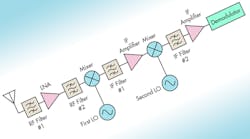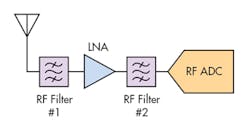The Differences Between Receiver Types, Part 2
This file type includes high-resolution graphics and schematics when applicable.
This two-part series examines various types of receiver implementations, focusing in on the roles played by receivers, as well as some of the characteristics that describe their performance. Part 1 analyzed both the direct-conversion and superheterodyne implementations. In Part 2, we’ll take a deeper look into the dual-conversion superheterodyne receiver, as well as discuss the newer direct RF-sampling technique.
Dual-Conversion Superheterodyne Receivers
Part 1 discussed the single-conversion implementation of the venerable superheterodyne receiver. However, dual-conversion superheterodyne receivers are often utilized, too, thanks to several key advantages (Fig. 1). This approach is particularly beneficial for higher-frequency applications, such as certain military radar receivers. In these instances, a high-frequency input signal is converted to an intermediate-frequency (IF) signal, which could be in the 1- to 3-GHz range. This signal is then converted again to an even lower frequency before being processed.
Given their name, dual-conversion receivers obviously have two frequency-conversion stages, meaning their configuration consists of two mixers as well as two local-oscillators (LOs). The first mixer converts the RF signal to a lower frequency, which can be called the first-IF frequency. The second mixer then converts this signal again to an even lower frequency, called the second-IF frequency. Although this configuration increases the complexity of a receiver, it also offers a number of advantages. On top of that, triple-conversion receivers are actually employed in some instances as well.
The image frequency band is an obstacle that presents itself in every superheterodyne receiver. When an RF input signal and an LO input signal enter a mixer, it generates an IF output signal at the mixer’s output. The frequency of this IF signal is equal to the difference of the RF input signal’s frequency and the LO signal’s frequency.
However, a different RF input signal along with the same LO signal can enter a mixer and generate the same IF output signal. This other input signal is known as an image frequency signal. It can be represented mathematically as follows:
|FRF – FLO| = FIF
|Fimage – FLO| = FIF
where:
FRF = frequency of the RF input signal
FLO = frequency of the LO signal
FIF = frequency of the IF output signal
Fimage = frequency of the image signal
To suppress these unwanted image frequencies, a superheterodyne receiver requires filtering prior to the mixer. However, converting a high-frequency input signal to a very-low-frequency signal in just one conversion stage causes a problem: The image band will be very close in frequency to the actual RF input band. Thus, filtering these image frequencies becomes a challenge because of their close proximity to the actual RF input frequencies.
A dual-conversion configuration can remedy this situation. Employing two frequency-conversion stages makes it possible to space the image frequency band further away from the actual input frequency band.
The increased separation between the input frequency band and the image frequency band is due to the higher first-IF frequency. Converting the RF input frequency to this first-IF frequency allows the image frequency band to be further away when compared with the approach of converting the input frequency to the lower final output frequency directly. Consequently, the task of filtering the image frequencies becomes much easier.
As stated, dual-conversion superheterodyne receivers have the benefit of a higher first-IF frequency, which allows them to achieve good image rejection. Furthermore, such receivers can also achieve excellent selectivity thanks to their lower second-IF frequency—greater selectivity is generally easier to obtain at lower frequencies. Thus, dual-conversion superheterodyne receivers can simultaneously achieve superior image rejection and selectivity.
Performance Tradeoffs
Direct-conversion receivers do offer some advantages versus their superheterodyne counterparts. For example, they avoid the image-frequency problem. They also require fewer components, leading to simpler, lower-cost solutions. In fact, as mentioned in Part 1, direct-conversion receivers are available as integrated circuits (ICs).
However, direct-conversion receivers are also plagued with several disadvantages. One of the biggest problems surrounds dc offset issues. For example, LO leakage mixing with the actual LO signal may inflict large dc offset errors on the output signal. LO leakage can be minimized by maintaining high isolation between a mixer’s LO and RF ports. Another way to resolve dc offset problems is by converting the input signal to a frequency that is close to, but not exactly, dc. This implementation is known as a low-IF receiver. However, using such an approach reintroduces the image-frequency problem.
Superheterodyne receivers offer a number of benefits, such as the ability to achieve unmatched selectivity and sensitivity. They also are immune to the dc problems that occur in direct-conversion receivers. However, as mentioned, superheterodyne receivers have to cope with the image-frequency band. In addition, they are generally much larger in size because they require components like bulky filters. Therefore, these receivers typically are not suitable to be designed as ICs.
Direct RF Sampling
Performance advances in analog-to-digital converters (ADCs) over the past few years have enabled them to directly digitize signals at RF frequencies. While operating at high frequencies, they can maintain low noise and good linearity.
These advanced ADCs have enabled the direct RF-sampling receiver (Fig. 2). They can directly sample signals at RF frequencies, thereby eliminating the need to convert an RF input signal to a lower frequency. This technique obviously represents a significant change from the traditional superheterodyne receiver. Now the promise of true software-defined radios (SDRs) can be fulfilled because of the capabilities of this new breed of ADCs.
A direct RF-sampling receiver basically consists of a low-noise amplifier (LNA), the required filters, and the ADC. The ADC digitizes the RF signal directly and sends it to a processor. Because frequency conversion is not required, the overall design of a direct RF-sampling receiver is much simpler in comparison to a superheterodyne receiver. The ADC essentially replaces the mixer, oscillator, and the entire IF signal chain found in superheterodyne configurations. Because they have fewer components, direct RF-sampling receivers can be built in smaller form factors.
Conclusion
It is obvious that receivers are critical to the performance of any communications system. Designers must take many factors into account during the development process. Performance characteristics like noise figure, selectivity, and sensitivity must be examined closely.
The superheterodyne receiver is a traditional implementation found in many applications. However, direct-conversion receivers are good fits in certain situations, too. Lastly, the direct-RF sampling technique, the most recent receiver implementation, is a technology to keep an eye on. It holds a great amount of promise for future wireless systems.
Looking for parts? Go to SourceESB.



